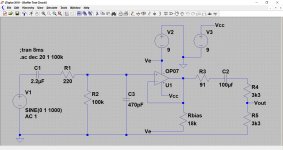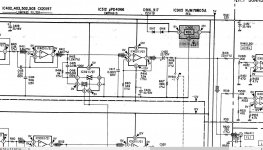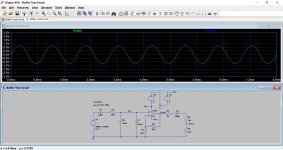The OPA2604 is a wonderful device and that would actually have been my recommend to you were it not for the fact that it is currently unavailable. There have been problems with the latest product not meeting spec when used at the extremes of its voltage rating which from memory is -/+22 volts.
Always try and buy from authorised distributers, although there are lots advertised they are a prime part to fake nowadays.
Always try and buy from authorised distributers, although there are lots advertised they are a prime part to fake nowadays.
But he hears a flea fart at 100ft so has gold hearing.
LOL! this cracked me up big time!
I have the same situation as you, I was an electronics tech 25 years ago,
so I have to relearn again, I go to GW and buy cd player for 5 bucks just to mess with them, it's fun.. and once in a while I find some that sounds just great.
Opamp swapping can be rewarding, but also has its pitfalls:
http://www.diyaudio.com/forums/anal...u-have-checked-see-its-stable-havent-you.html
If they are dual opamps (5532 4558 etc) then you probably stand a better chance of them being 'plug and play' whereas singles may not be guaranteed so easy. As always, verify by at least using a scope and seeing nothing untoward is going on.
Indeed, high-frequency oscillation is the common bad side of op-amps swapping especially if the new device parameters do not match. Still, lots of people use this process in an attempt of improving sound quality performance. As most op-amps have the same pin-outs, replacement is pretty simple making it widely used in most audio devices.
I first used 4562 in a sony cdp302 as it was among the recommended OAs for upgrading and it did sound alot better than the stock sony OAs.
In a second sony 302 I put in 2604s and the improvement was immediately audible.
So I have settled on the 2604 as my goto OP for any future cdp upgrades.
At least until someone says that xxxx OA sounds much much better. I will try it as I have used sockets for ease of replacment. This quest for better SQ is really fun. never knew it could be so easy. and its lowcost too.
PS: While in there I also relaced all the little Vcc, Vdd, supply decoupling caps surrounding the Opamps, just to be sure they were getting good , steady voltages. there were 12 of them i replaced. Now THAT was abit of a job.
In a second sony 302 I put in 2604s and the improvement was immediately audible.
So I have settled on the 2604 as my goto OP for any future cdp upgrades.
At least until someone says that xxxx OA sounds much much better. I will try it as I have used sockets for ease of replacment. This quest for better SQ is really fun. never knew it could be so easy. and its lowcost too.
PS: While in there I also relaced all the little Vcc, Vdd, supply decoupling caps surrounding the Opamps, just to be sure they were getting good , steady voltages. there were 12 of them i replaced. Now THAT was abit of a job.
Last edited:
I first used 4562 in a sony cdp302 as it was among the recommended OAs for upgrading and it did sound alot better than the stock sony OAs.
In a second sony 302 I put in 2604s and the improvement was immediately audible.
So I have settled on the 2604 as my goto OP for any future cdp upgrades.
At least until someone says that xxxx OA sounds much much better. I will try it as I have used sockets for ease of replacment. This quest for better SQ is really fun. never knew it could be so easy. and its lowcost too.
PS: While in there I also relaced all the little Vcc, Vdd, supply decoupling caps surrounding the Opamps, just to be sure they were getting good , steady voltages. there were 12 of them i replaced. Now THAT was abit of a job.
I am going to try this opamp, as I have been having fun lately doing the same things you are doing.. but let me ask you, since you are happy with the results of your modification, have you biased the op amps into class A? I did and they sounded pleasantly better to my ears! Cheers!
There are at least three ways of doing it and one can be tried very easily 
This is your simplest method with a resistor (Rbias here) connected between the opamp output and the negative rail. 18k is to high though and something nearer 10k would be better. This circuit was from another experimental thread.
This is your simplest method with a resistor (Rbias here) connected between the opamp output and the negative rail. 18k is to high though and something nearer 10k would be better. This circuit was from another experimental thread.
Attachments
my sony 302 uses 2 dual OAs per ch making up the low pass filter.
3 of the 4 amps are followers while the last one has the out tied to the input thru a 3.6k R
which I assume would be the amp to do the bias on at the output with a 10k R to Vneg.
HIFIENGINE has the svc mnl with schematic if you need to see the ccircuit.
Am I seeing it right?
3 of the 4 amps are followers while the last one has the out tied to the input thru a 3.6k R
which I assume would be the amp to do the bias on at the output with a 10k R to Vneg.
HIFIENGINE has the svc mnl with schematic if you need to see the ccircuit.
Am I seeing it right?
Last edited:
This is what I am looking at. All the resistors you can see in the signal path either set the gain of the stage (such as R416/R415) or help define a filter characteristic (R412 in combination with the switched network of R413 and associated components) or are used to enable the opamp output to be safely shorted (R418 and the mute relay).
Attachments
You would really have to do it for all the opamps in order to make a real judgement because all are in the audio path. The opamps that see the highest current swings in the output signal would be the ones to theoretically benefit most.
R416/415 set the gain of that opamp. Gain = (3k9/3k6) + 1 which is a gain of 2.08
Altering the buffer circuit I posted above to include these resistors confirms the gain. 1 volt peak applied, 2.08 volts peak at the output.
So depending on the impedance of your preamp (which connects to the last opamp), the two devices before could be the most 'stressed'.
Post #11 here
ABX Testing. Please have a listen.
has an audio file attached that highlights class a biasing but remember the opamp used suffers from crossover distortion from its current limited output stage.
And if you are really really interested in opamp sound then these were a bit of an eye opener under the given test conditions:
Hires 96/24 listening test of opamps
(I'm not sure if Pavel's files are still available)
R416/415 set the gain of that opamp. Gain = (3k9/3k6) + 1 which is a gain of 2.08
Altering the buffer circuit I posted above to include these resistors confirms the gain. 1 volt peak applied, 2.08 volts peak at the output.
So depending on the impedance of your preamp (which connects to the last opamp), the two devices before could be the most 'stressed'.
Post #11 here
ABX Testing. Please have a listen.
has an audio file attached that highlights class a biasing but remember the opamp used suffers from crossover distortion from its current limited output stage.
And if you are really really interested in opamp sound then these were a bit of an eye opener under the given test conditions:
Hires 96/24 listening test of opamps
(I'm not sure if Pavel's files are still available)
Attachments
- Status
- This old topic is closed. If you want to reopen this topic, contact a moderator using the "Report Post" button.
- Home
- Source & Line
- Digital Source
- CD upgrading?


